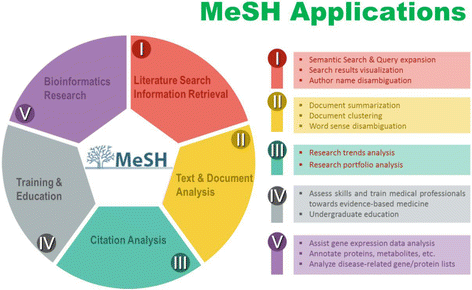MeSH Now: automatic MeSH indexing at PubMed scale via learning to rank
- PMID: 28412964
- PMCID: PMC5392968
- DOI: 10.1186/s13326-017-0123-3
MeSH Now: automatic MeSH indexing at PubMed scale via learning to rank
Abstract
Background: MeSH indexing is the task of assigning relevant MeSH terms based on a manual reading of scholarly publications by human indexers. The task is highly important for improving literature retrieval and many other scientific investigations in biomedical research. Unfortunately, given its manual nature, the process of MeSH indexing is both time-consuming (new articles are not immediately indexed until 2 or 3 months later) and costly (approximately ten dollars per article). In response, automatic indexing by computers has been previously proposed and attempted but remains challenging. In order to advance the state of the art in automatic MeSH indexing, a community-wide shared task called BioASQ was recently organized.
Methods: We propose MeSH Now, an integrated approach that first uses multiple strategies to generate a combined list of candidate MeSH terms for a target article. Through a novel learning-to-rank framework, MeSH Now then ranks the list of candidate terms based on their relevance to the target article. Finally, MeSH Now selects the highest-ranked MeSH terms via a post-processing module.
Results: We assessed MeSH Now on two separate benchmarking datasets using traditional precision, recall and F1-score metrics. In both evaluations, MeSH Now consistently achieved over 0.60 in F-score, ranging from 0.610 to 0.612. Furthermore, additional experiments show that MeSH Now can be optimized by parallel computing in order to process MEDLINE documents on a large scale.
Conclusions: We conclude that MeSH Now is a robust approach with state-of-the-art performance for automatic MeSH indexing and that MeSH Now is capable of processing PubMed scale documents within a reasonable time frame.
Availability: http://www.ncbi.nlm.nih.gov/CBBresearch/Lu/Demo/MeSHNow/ .
Figures
Similar articles
-
Recommending MeSH terms for annotating biomedical articles.J Am Med Inform Assoc. 2011 Sep-Oct;18(5):660-7. doi: 10.1136/amiajnl-2010-000055. Epub 2011 May 25. J Am Med Inform Assoc. 2011. PMID: 21613640 Free PMC article.
-
MeSH indexing based on automatically generated summaries.BMC Bioinformatics. 2013 Jun 26;14:208. doi: 10.1186/1471-2105-14-208. BMC Bioinformatics. 2013. PMID: 23802936 Free PMC article.
-
Influence of automated indexing in Medical Subject Headings (MeSH) selection for pharmacy practice journals.Res Social Adm Pharm. 2024 Sep;20(9):911-917. doi: 10.1016/j.sapharm.2024.06.003. Epub 2024 Jun 12. Res Social Adm Pharm. 2024. PMID: 38902136
-
Machine learning models for abstract screening task - A systematic literature review application for health economics and outcome research.BMC Med Res Methodol. 2024 May 9;24(1):108. doi: 10.1186/s12874-024-02224-3. BMC Med Res Methodol. 2024. PMID: 38724903 Free PMC article.
-
Orthopaedic literature and MeSH.Clin Orthop Relat Res. 2010 Oct;468(10):2621-6. doi: 10.1007/s11999-010-1387-4. Clin Orthop Relat Res. 2010. PMID: 20623263 Free PMC article. Review.
Cited by
-
Tackling Research Inefficiency in Degenerative Cervical Myelopathy: Illustrative Review.JMIR Res Protoc. 2020 Jun 11;9(6):e15922. doi: 10.2196/15922. JMIR Res Protoc. 2020. PMID: 32525490 Free PMC article.
-
ML-Net: multi-label classification of biomedical texts with deep neural networks.J Am Med Inform Assoc. 2019 Nov 1;26(11):1279-1285. doi: 10.1093/jamia/ocz085. J Am Med Inform Assoc. 2019. PMID: 31233120 Free PMC article.
-
Algorithmic indexing in MEDLINE frequently overlooks important concepts and may compromise literature search results.J Med Libr Assoc. 2025 Jan 14;113(1):39-48. doi: 10.5195/jmla.2025.1936. J Med Libr Assoc. 2025. PMID: 39975491 Free PMC article.
-
ChatGPT in academic writing: Maximizing its benefits and minimizing the risks.Indian J Ophthalmol. 2023 Dec 1;71(12):3600-3606. doi: 10.4103/IJO.IJO_718_23. Epub 2023 Nov 20. Indian J Ophthalmol. 2023. PMID: 37991290 Free PMC article. Review.
-
Using deep learning to identify translational research in genomic medicine beyond bench to bedside.Database (Oxford). 2019 Jan 1;2019:baz010. doi: 10.1093/database/baz010. Database (Oxford). 2019. PMID: 30753477 Free PMC article.
References
MeSH terms
LinkOut - more resources
Full Text Sources
Other Literature Sources
Miscellaneous



